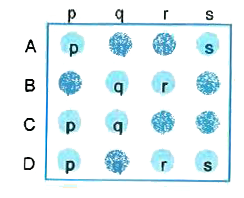If X and Y are random variables and a, b, c, d are constants such that a≠0,c≠0 then
r(aX+b,cY+d) is
r(X,Y)
acr(X,Y)
|ac|acr(X,Y)
none of these
The correct Answer is:C
To solve the problem of finding r(aX+b,cY+d) where a,b,c,d are constants and a≠0,c≠0, we will use the properties of covariance and variance. Here are the steps to derive the solution:
1. Understanding the Correlation Formula:
The correlation coefficient r(X,Y) is defined as:
r(X,Y)=Cov(X,Y)√Var(X)⋅Var(Y)
2. Applying the Transformation:
We need to find r(aX+b,cY+d). Using the properties of covariance:
Cov(aX+b,cY+d)=a⋅c⋅Cov(X,Y)
The constants b and d do not affect the covariance.
3. Calculating the Variance:
The variance of a transformed variable is given by:
Var(aX+b)=a2⋅Var(X)
and
Var(cY+d)=c2⋅Var(Y)
4. Substituting into the Correlation Formula:
Now substituting these results back into the correlation formula:
r(aX+b,cY+d)=Cov(aX+b,cY+d)√Var(aX+b)⋅Var(cY+d)
This becomes:
r(aX+b,cY+d)=a⋅c⋅Cov(X,Y)√(a2⋅Var(X))⋅(c2⋅Var(Y))
5. Simplifying the Expression:
The denominator simplifies to:
√a2⋅c2⋅Var(X)⋅Var(Y)=|a|⋅|c|⋅√Var(X)⋅Var(Y)
Thus, we can rewrite the correlation as:
r(aX+b,cY+d)=a⋅c⋅Cov(X,Y)|a|⋅|c|⋅√Var(X)⋅Var(Y)
6. Final Result:
This simplifies to:
r(aX+b,cY+d)=a⋅c|a|⋅|c|⋅r(X,Y)
Since a and c are non-zero constants, we can express this as:
r(aX+b,cY+d)=sgn(a)⋅sgn(c)⋅r(X,Y)
where sgn(x) is the sign function.
Conclusion:
Thus, the final answer is:
r(aX+b,cY+d)=a⋅c|a|⋅|c|⋅r(X,Y)
The correlation coefficient r(X,Y) is defined as:
r(X,Y)=Cov(X,Y)√Var(X)⋅Var(Y)
We need to find r(aX+b,cY+d). Using the properties of covariance:
Cov(aX+b,cY+d)=a⋅c⋅Cov(X,Y)
The constants b and d do not affect the covariance.
The variance of a transformed variable is given by:
Var(aX+b)=a2⋅Var(X)
and
Var(cY+d)=c2⋅Var(Y)
Now substituting these results back into the correlation formula:
r(aX+b,cY+d)=Cov(aX+b,cY+d)√Var(aX+b)⋅Var(cY+d)
This becomes:
r(aX+b,cY+d)=a⋅c⋅Cov(X,Y)√(a2⋅Var(X))⋅(c2⋅Var(Y))
The denominator simplifies to:
√a2⋅c2⋅Var(X)⋅Var(Y)=|a|⋅|c|⋅√Var(X)⋅Var(Y)
Thus, we can rewrite the correlation as:
r(aX+b,cY+d)=a⋅c⋅Cov(X,Y)|a|⋅|c|⋅√Var(X)⋅Var(Y)
This simplifies to:
r(aX+b,cY+d)=a⋅c|a|⋅|c|⋅r(X,Y)
Since a and c are non-zero constants, we can express this as:
r(aX+b,cY+d)=sgn(a)⋅sgn(c)⋅r(X,Y)
where sgn(x) is the sign function.
Thus, the final answer is:
r(aX+b,cY+d)=a⋅c|a|⋅|c|⋅r(X,Y)
Topper's Solved these Questions
- CORRELATION AND REGRESSION BOOK - ML KHANNACHAPTER - CORRELATION AND REGRESSION EXERCISE - PROBLEM SET (1) TRUE/FALSE
6 Videos
- CORRELATION AND REGRESSION BOOK - ML KHANNACHAPTER - CORRELATION AND REGRESSION EXERCISE - PROBLEM SET (1) (FILL IN THE BLANKS)
10 Videos
- CORRELATION AND REGRESSION BOOK - ML KHANNACHAPTER - CORRELATION AND REGRESSION EXERCISE - QUESTION (STATE GIVING REASONS, WHETHER EACH OF THE FOLLOWING STATEMENTS IS TRUE OR FALSE)
10 Videos
- CONCEPTS OF SET THEORY BOOK - ML KHANNACHAPTER - CONCEPTS OF SET THEORY EXERCISE - Self Assessment Test
13 Videos
- DEFINITE INTEGRALBOOK - ML KHANNACHAPTER - DEFINITE INTEGRALEXERCISE - Miscellaneous Questions (Assertion/Reason)
1 Videos
Similar Questions
If a random variable x assumes the values 0,1 and 2 with probabilities 0.30,0.50 and 0.20, then its expected value is (A) 1.50 (B) 3 (C) 0.90 (D) 1
View SolutionIf the lines ax+by+c=0,bx+cy+a=0andcx+ay+b=0(a,b,c being distinct) are concurrent, then (A) a+b+c=0 (B) a+b+c=0 (C) ab+bc+ca=1 (D) ab+bc+ca=0
View Solution
Knowledge Check
If s.d. of X is σ then s.d. of the variable U=aX+bc where a,b,c are constants is
A∣∣ca∣∣σB∣∣ac∣∣σC∣∣∣bc∣∣∣σDc2a2σIf σ is the standard deviation of a random variable x, then the standard deviation of the random variable ax +b, where a, b ∈ R, is
Aaσ+bB|a|σC|a|σ+bDa2σIf U=aX+b,andV=−cY+d where a and c positive. If r(U,V)=0.6, then r(X,Y) is equal to
A0.6B−0.6C0.6caD0.6ac
Each question contains statements given in two columns , which have to be matched . Statements in olumn I are labelled as A, B, C and D , whereas statemets in column II are labelled as p,q,r, and s. Match the entries of column I with appropriate entries of column I amy have one or more than one correct option from column II. The answer to these questions have to be appropriately bubbled as illustrated in the given example , if the correct matches are A→(q,r),B→(p,s),C→(r,s)andD→(q).

If u is iitial speed of a particle and a is constant acceleration .
(ColumnI, ColumnII),((A)u=0,a≠0,,(p)Rest),((B)u≠0,a=0,,(q)Straight line),((C)u≠0,a≠0,,(r)Parabola),((D)u=0,a=0,,(s)Circle)
View SolutionFind a zero of the polynomial p(x)=ax+b,a≠0 and a , b are real numbers.
View SolutionLet a, b, c, d be distinct real numbers such that a, b are roots of x2−5cx−6d=0 and c, d are roots of x2−5ax−6b=0. Then b+d is
View SolutionIf y=sin(ax+b), then what is d2ydx2 at x=−ba, where a, be are constants and a≠0?
View SolutionIf the two lines represented by x+ay=b,z+cy=dandx=a'y+b',z=c'y+d' be perpendicular to each other, then the value of aa'+cc' is :
View Solution
